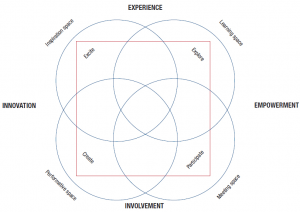Recently, my staff and I embarked on a journey with the goal to redesign our library space to meet future needs. In this process, we made extensive use of the so-called four space model, which offers a framework for discussions of new values of the public library and as a tool for designing, developing, and redesigning the library.
Danish LIS-scientists Dorte Skot-Hansen, Henrik Jochumsen and Casper Hvenegaard Hansen introduced the model to describe the transformation of the public library from a passive collection based space to a more active space for experience and inspiration and a local meeting point.
The four space-model plays a significant role in ‘The Model Programme for Public Libraries’ that I described in my last blogpost.
The model consists of four different overlapping ‘spaces’: the inspiration space, the learning space, the meeting space and the performative space. These four spaces’ overall objective is to support the following four goals for the public library in the future:
- Experience
- Involvement
- Empowerment
- Innovation
The four spaces are not to be seen as concrete ‘rooms’ in a physical sense, but rather as possibilities that can be fulfilled both in the physical library and in cyberspace.
Fig. 1: The four spaces by Dorte Skot-Hansen, Henrik Jochumsen and Casper Hvenegaard Hansen
Inspiration Space
This space for meaningful experiences transforms our perception. This can happen through story-telling and other artistic expressions within all media, culture patterns and genres. The inspiration space should make you want to move beyond your familiar choices, and therefore the space must open up for the irrational, emotional and chaotic by mediating a multitude of aesthetic experiences.
Learning space
The learning space particularly underpins experience and empowerment. This is the space were children, youngsters and adults can discover and explore the world and thereby increase their competences and possibilities through free and unrestricted access to information and knowledge. Learning in the library is always an offer. It happens through play, artistic activities, courses and many other activities.
Meeting space
The meeting space is an open, public space and a place between work and home where the citizens can meet other people, who are both like them and differ from them. In a segmented society, you need platforms where you come across people with different interests and values from your own and encounter opinions that challenge you through discussion and debate. The meeting space provides the frames for non-committal, accidental meetings in both small intimate spaces as well as in lounge areas with newspapers and café facilities and as in more organized meetings, where topics and problems can be analyzed and discussed. Meetings can happen live as well as on the net through chat groups, blogs or other social technologies.
Performative space
The performative space particularly supports involvement and innovation. In the performative space the users, in an interaction with others, can be inspired to create new artistic expressions in the meeting with art and culture. Here they have access to tools that support their creative activities through interactive games, writing-, sound- and video, and they can get support for their creative activities through workshops with professional artists, designers, multimedia developers etc. Finally, the performative space can act as a platform for mediation by publishing and distributing the users’ work and products and providing stages for their activities.
If you want to redesign your library, I recommend you take a look at the model and consider how you want to integrate the four spaces in your library and which ones you wish to empathize.


